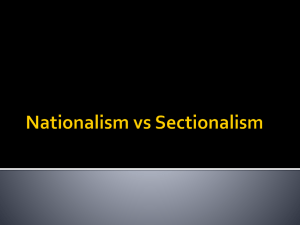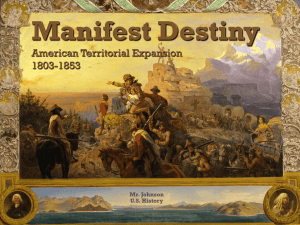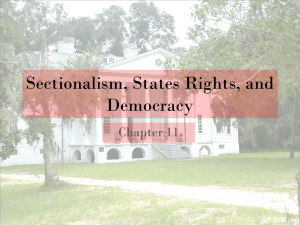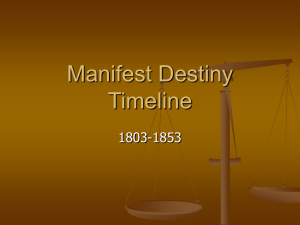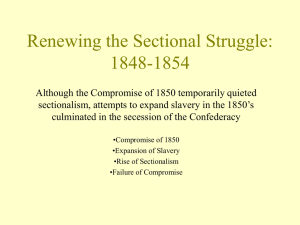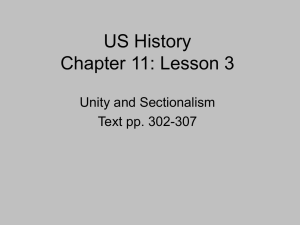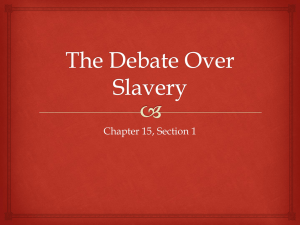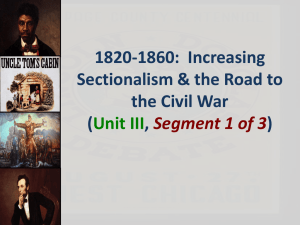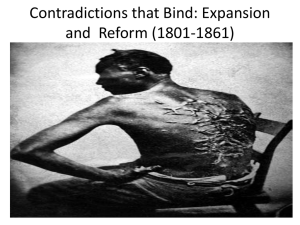Objectives for Goal 2: Expansion and Reform
advertisement
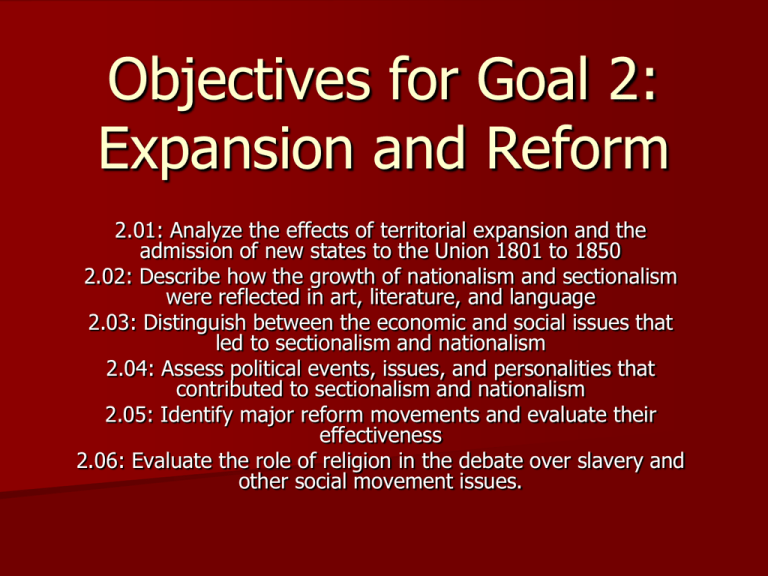
Objectives for Goal 2: Expansion and Reform 2.01: Analyze the effects of territorial expansion and the admission of new states to the Union 1801 to 1850 2.02: Describe how the growth of nationalism and sectionalism were reflected in art, literature, and language 2.03: Distinguish between the economic and social issues that led to sectionalism and nationalism 2.04: Assess political events, issues, and personalities that contributed to sectionalism and nationalism 2.05: Identify major reform movements and evaluate their effectiveness 2.06: Evaluate the role of religion in the debate over slavery and other social movement issues. What is “Nationalism”? After the War of 1812, the memories of the American Revolution faded, including memories of what it had been like to be 13 individual colonies. Americans began thinking of themselves as one “United” country of states. Webster’s 1828 Dictionary His book contained 70,000 words, of which 12,000 had never appeared in a published dictionary before. As a spelling reformer, Webster believed that British spelling rules were unnecessarily complex, so his dictionary introduced American English spellings, replacing "colour" with "color", substituting "wagon" for "waggon", and printing "center" instead of "centre". He also added new American words. What was the greatest impact this publication had on America? Examples of Nationalism Pres. James Monroe: “Era of Good Feelings” (1818-1824) Henry Clay’s “American System” Monroe Doctrine Monroe Doctrine “…as a principle in which the rights and interests of the United States are involved, that the American continents, by the free and independent condition which they have assumed and maintain, are henceforth not to be considered as subjects for future colonization by any European powers.” – Pres. James Monroe What does this mean? How did the following issues create “sectionalism” in the United States? Re-chartering of the National Bank Tariffs Settlers moving West Industrial Revolution Slavery How did the following issues create “sectionalism” in the United States? Re-chartering of the National Bank – Created by ________________ in 1790 to help the nation be responsible with its finances – The bank’s charter expired in 1811 and state run banks begin popping up all over the U.S. – In 1816, the bank was re-chartered with corrupt and irresponsible management. – ________ of 1819 resulted in hatred between the _______ and ________ . How did the following issues create “sectionalism” in the United States? Tariffs – As tariffs during the War of 1812 ________, Congress voted to keep them at those levels. – Tariffs benefited most Americans in 2 ways: 1. ______________________ 2. ______________________ This eventually created sectionalism between the _____________ and the _________________. How did the following issues create “sectionalism” in the United States? Settlers moving West “We will keep out nobody. Arrivals will suffer no disadvantages as aliens. But they can expect no advantages either.” – John Quincy Adams – 1820 Congress decreased cost of buying land in the West – The West supported this move, but the North and East disliked this because ____________________________________. How did the following issues create “sectionalism” in the United States? Industrial Revolution – __ out of 10 Americans were farmers up until the War of 1812. – War stopped trade of manufactured good from Europe, therefore there was a boom in products “Made in the USA”. – Inventions! Inventions! Interchangeable parts: Erie Canal: Steam power: Sewing machine: Morse code: Erie Canal How did the following issues create “sectionalism” in the United States? Slavery – How did these inventions increase slavery? Cotton Gin Sugar cultivation Steel plow – In 1800, an average slave cost $50, by 1850, the cost was more than $ _______. – In 1800, there were 900,000 slaves, by 1860, there were nearly ____________. How did the ________ and the ________ each view slavery? Justifying Slavery Slaves were encouraged to be devout Christians, but the Christian message they received from planters and ministers was to be docile and submissive. It was God’s will that they spent their lives as slaves and sermons capitalized on such themes as “obeying the master.” What religious movement changed this later? _________________________________________ Primary Source: Slave Codes Virginia – "If any slave resists his master...correcting such a slave, and shall happen to be killed in such correction...the master shall be free of all punishment...as if such accident never happened." South Carolina – “.... Every slave hereafter out of his master's plantation, without a ticket, or leave in writing, from his master...shall be whipped...." Louisiana - "The slave who, having struck his master, his mistress, or the husband of his mistress, or their children, shall have produced a bruise, or the shedding of blood in the face, shall suffer capital punishment." What was the Missouri Compromise? 1819 Missouri petitioned for statehood. America now had ____ free states and ____ slave states. The compromise settled the issue in 2 ways: 1. ________________________ 2. ________________________ Exit Ticket Question Write North, South or West on your index card in response to each question below: 1. Which region favored the National Bank of the US? 2. Which region became too dependent on only one product for trade? 3. Which region opposed tariffs? 4. Which region was happy that Congress lowered the price of land per acre? 5. Which region primarily based its economy and factories and manufacturing? 1. 2. 3. 4. 5. 6. 7. 8. 9. 10. Define “nationalism” In addition to a good economy, what is one other factor that usually helps countries feel united and nationalistic? In addition to re-chartering the National Bank, what did Henry Clay want to fund with federal money for his “American System”? The Monroe Doctrine warned “who” to stay out of the Americas. The Panic of 1819 created sectionalism between which two regions of the country? What was one way Tariffs benefited some Americans? What state benefited most from the building of the Erie Canal? What invention by Eli Whitney helped to make slavery a prosperous industry? Slavery created sectionalism between which two regions? Name the 2 components of the Missouri Compromise that tried to settle the issue of slavery in the United States. Bell Ringer 1. 2. 3. Write your name on the index card Number from 1 – 10 (leave some space for short answer questions) On the back of the card, write the following: – “Education will give me the power to….” 4. Take out your notes from yesterday and WAIT for further instructions! Objectives for Goal 2: Expansion and Reform 2.01: Analyze the effects of territorial expansion and the admission of new states to the Union 1801 to 1850 2.02: Describe how the growth of nationalism and sectionalism were reflected in art, literature, and language 2.03: Distinguish between the economic and social issues that led to sectionalism and nationalism 2.04: Assess political events, issues, and personalities that contributed to sectionalism and nationalism 2.05: Identify major reform movements and evaluate their effectiveness 2.06: Evaluate the role of religion in the debate over slavery and other social movement issues. Manifest Destiny What was the moral justification behind Manifest Destiny? How did Americans’ attitude about Manifest Destiny affect Native Americans? ____________ River School Art What would be some results of Americans viewing this new type of art? (also see page 113) Art and Literature During Expansion Period Transcendentalism: – A new way to look at humanity and nature and God. – They believed people could go beyond, or ____________, their senses to learn about the world. – Believing should listen to their __________ instead of religious teachings to learn about the world. Art and Literature During Expansion Period Transcendentalism: – ____________________ was the leading Transcendentalist of his time. – Henry David Thoreau wrote his famous work “___________________” after being jailed for not paying taxes to support war, which later affected Civil Rights leaders in the 1960’s. “people must be true to his or her own conscience, even if it means breaking the law.” Winning Texas Mexico wins its independence from ______ in 1821. Who was Stephen F. Austin? Who were Texians? Winning Texas Who was Santa Anna and what did he do in 1835? What happened at the Alamo? Winning Texas What happened at the Battle of San Jacinto? Why did it take so long for Texas to join the United States? Cornell Notes: Jackson’s Bank War 1819: What happened in McCullough vs. 1832: What starts Jackson’s “Bank War”? What was “The Monster”? 1833: What were “pet banks”? 1837: What happens to the Second National Bank and the “pet banks”? Maryland? James Polk 1844 Campaign Secured the Oregon Territory (54’ 40’ or Fight!) Purchased half a million square miles of land in Treaty of Guadalupe Hidalgo (end of MexicanAmerican War) Founded the Smithsonian Institute (“increase and diffusion of knowledge” about American) Based on Polk’s actions as President, what could a summary of this Presidency be? Manifest Destiny! 1819: From who did we get Florida Territory? 1820-1840: What state were Indians removed to in forced marches? 1846-1848: Why did the Mexican War start? 1848: What two major states were given the United States after the Mexican War in what is known as Mexican Cession? 1853: What was the result of the Gadsden Purchase? 1845: What was the last slave state to be admitted to the Union?
